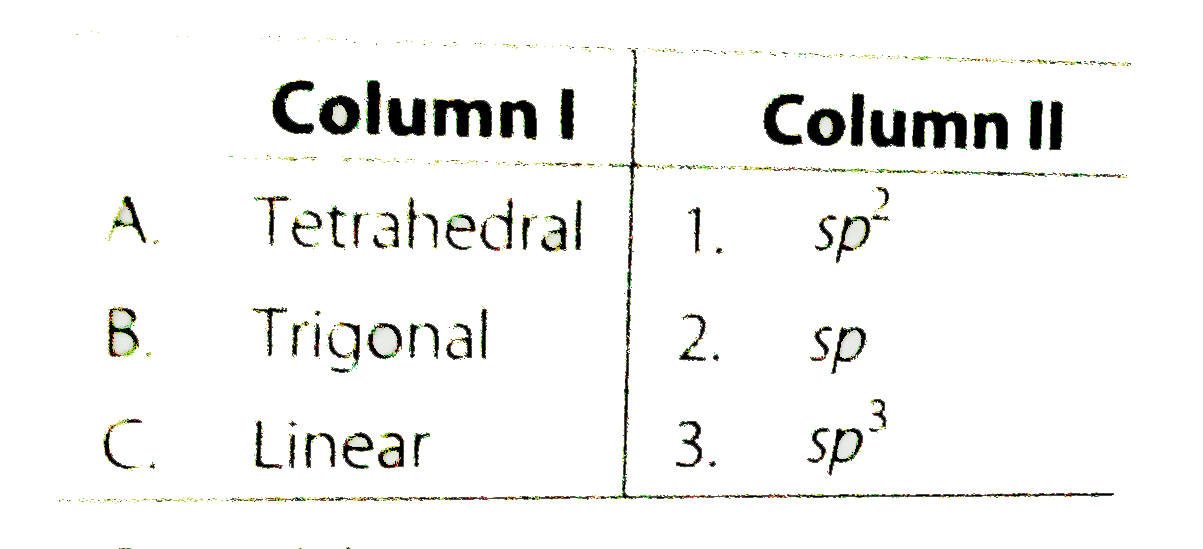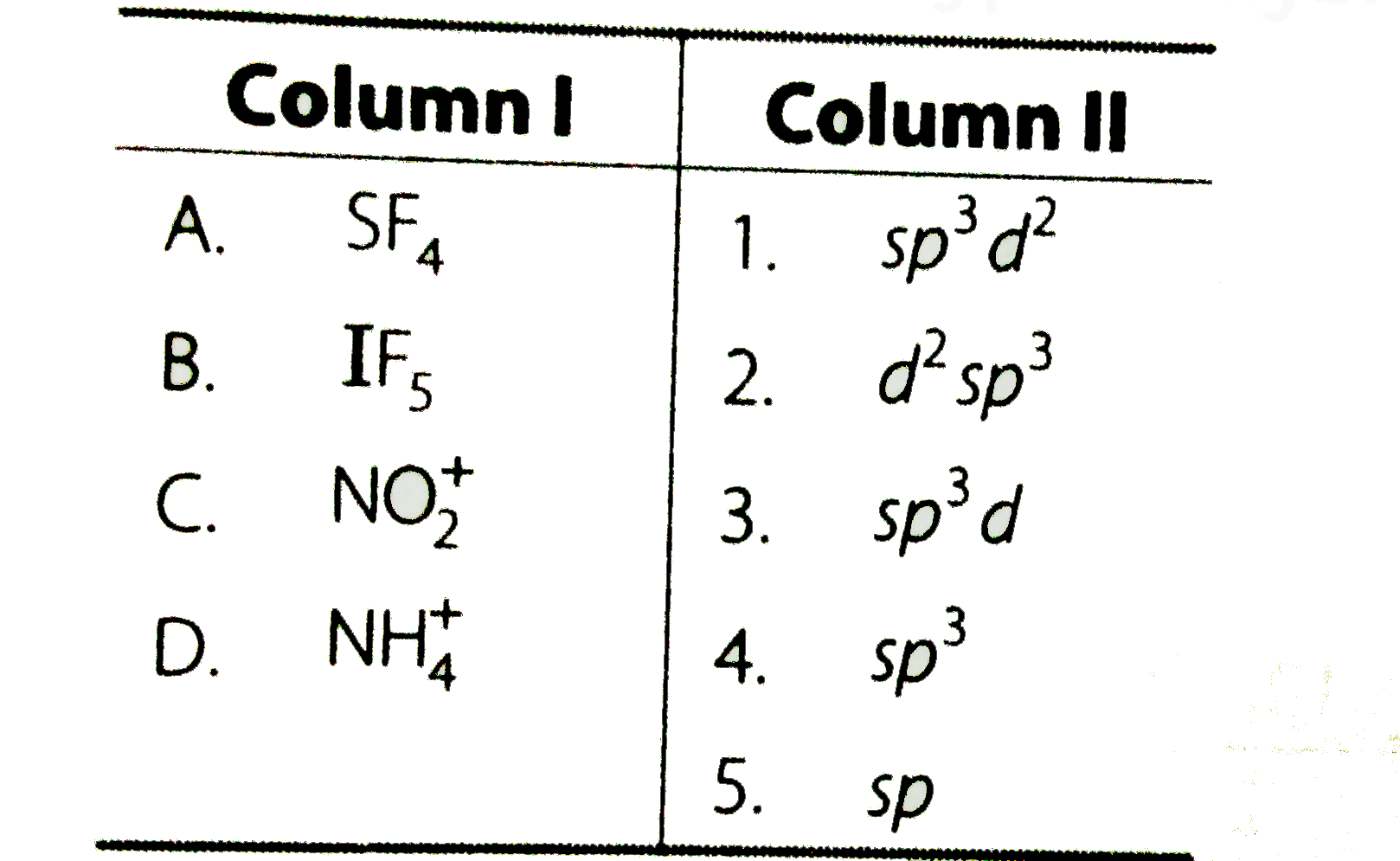Match the species given in Column I with hybridisation given in Column II.
Column-IColumn-IIA.Boron in[B(OH4)]−1.sp2B.Aluminium in[Al(H2O)6]3+2.sp3C.Boron in B2H63.sp3d2D.Carbon in buckminster fullereneE.Silicon in SiO4−4F.Germanium in[GeCl6]2−
The correct Answer is:(i)→(b);(ii)→(c);(iii)→(b);(iv)→(a);(v)→(b);(vi)→(c).
Step by step video, text & image solution for Match the species given in Column I with hybridisation given in Column II. {:(,"Column-I",,"Column-II"),("A.","Boron in"[B(OH_(4))]^(-),1.,sp^(2)),("B.","Aluminium in"[Al(H_(2)O)_(6)]^(3+),2.,sp^(3)),("C.","Boron in "B_(2)H_(6),3.,sp^(3)d^(2)),("D.","Carbon in buckminster fullerene",,),("E.","Silicon in "SiO_(4)^(4-),,),("F.","Germanium in"[GeCl_(6)]^(2-),,):} by Chemistry experts to help you in doubts & scoring excellent marks in Class 11 exams.
Topper's Solved these Questions
- BOOK - PRADEEPCHAPTER - SOME p-BLOCK ELEMENTSEXERCISE - NCERT EXEMPLAR PROBLEMS WITH ANSWER, HINTS AND SOLUTIONS (ASSERTION AND REASON TYPE QUESTIONS)2videos
SOME p-BLOCK ELEMENTS
- BOOK - PRADEEPCHAPTER - SOME p-BLOCK ELEMENTSEXERCISE - NCERT EXEMPLAR PROBLEMS WITH ANSWER, HINTS AND SOLUTIONS (LONG ANSWER QUESTIONS)9videos
SOME p-BLOCK ELEMENTS
- BOOK - PRADEEPCHAPTER - SOME p-BLOCK ELEMENTSEXERCISE - NCERT EXEMPLAR PROBLEMS WITH ANSWER, HINTS AND SOLUTIONS (SHORT ANSWER QUESTIONS)14videos
SOME p-BLOCK ELEMENTS
- BOOK - PRADEEPCHAPTER - SOLID STATE EXERCISE - Advanced problems19videos
SOLID STATE
- BOOK - PRADEEPCHAPTER - STATES OF MATTER : GASES AND LIQUIDESEXERCISE - VIII. ASSERTION-REASON TYPE QUESTIONS (TYPE-II)12videos
STATES OF MATTER : GASES AND LIQUIDES
Similar Questions
Match the species given in Column I with hybridisation given in Column II.
Column-IColumn-IIA.Boron in[B(OH4)]−1.sp2B.Aluminium in[Al(H2O)6]3+2.sp3C.Boron in B2H63.sp3d2D.Carbon in buckminster fullereneE.Silicon in SiO4−4F.Germanium in[GeCl6]2−View SolutionMatch the species in Column I with the type of hybrid orbitals in Column II.
Column IColumn II(i)BF3(a)sp3d(ii)H2O(b)sp2(iii)PCl5(c)sp3d2(iv)SF6(d)sp3View SolutionMatch the shape of molecules in Column I with the type of hybridisation in Column II.
 View Solution
View SolutionMatch the species in Column I with the bond order in Column II
Column I Column II (i)NO (a)1.5(ii)CO (b)2.0(iii)O−2 (c)2.5(iv)O2 (d)3.0View SolutionMatch the shape of molecules in Column 1 with the type of hybridisation in Column II.
Column IColumn II(a)Tetrahedral(i)sp2(b)Trigonal(ii)sp(c)Linear(iii)sp3(d)Trigonal bipyramidal(iv)sp3dView SolutionMatch the items given in Column 1 with examples give in Column II.
Column IColumn II(a)Hydrogen bond(i)C(b)Resonance(ii)LiF(c)Ionic solid(iii)H2(d)Covalent solid(iv)HF(v)O3View SolutionMatch the species in Column 1 with the type of hybrid orbitals in Column II.
Column IColumn II(a)SF4(i)sp3d2(b)lF5(ii)d2sp3(c)NO+2(iii)sp3d(d)NH+4(iv)sp3(v)spView SolutionMatch species given in Column I with the electronic configuration given in Column II.
Column IColumn II(a)cr(i)[Ar]3d84s0(b)Fe2+(ii)[Ar]3d104s1(c)Ni2+(iii)[Ar]3d64s0(d)Cu(iv)[Ar]3d54s1(v)[Ar]3d64s2View SolutionMatch the items given in Column I with examples given in Column II.
 View Solution
View SolutionMatch the species in Column I with the type of hybrid orbitals in Column II.
 View Solution
View Solution

